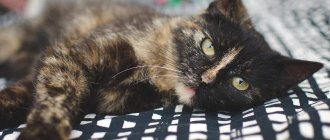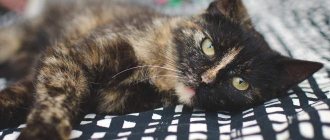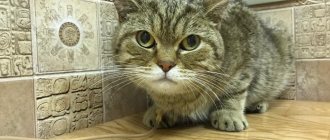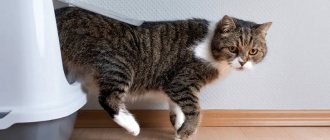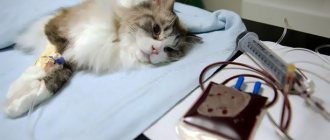Why do many people think that white cats are deaf?
The fact is that in snow-whites the epistatic gene W is dominant. It is often confused with albinism, but in fact it is not the same thing at all. It is the presence of this gene that explains the fact that 2 out of 10 white cats actually cannot hear anything. But this gene can, with a high degree of probability, appear in the genotype of red, black, and even tabby cats, and they can also turn out to be deaf. Moreover, this gene is passed from parent to offspring, so some of the kittens in such a litter may be deaf, regardless of their fur color. But albinism, which is in no way connected with deafness, is responsible for the white color of the coat.
Features of congenital deafness
Many owners know the fact that white cats with blue eyes often have a congenital defect such as deafness. Such cats have a special dominant W gene in their genotype. It is the presence of this gene that makes the likelihood that a white cat will be deaf very high. In some cases it reaches 80%. In turn, congenital deafness in individuals of a different color is an extremely rare phenomenon.
The dominant W gene is pleiotropic, that is, it is responsible for the presence of several traits at once. In addition to white coat color and deafness, it also makes blue eye color dominant. The probability of deafness among white individuals is distributed as follows:
- animals with blue eyes are deaf in 80% of cases;
- animals with heterochromic eyes (one eye is blue and the other is a different color) are deaf in 40% of cases;
- animals with eyes of any color (except blue) are deaf in 20% of cases.
It has been noted that deafness in white cats, caused by the presence of this gene, can be either unilateral or bilateral (long-haired beauties most often suffer from it).
How does deafness develop in white individuals?
It is known that absolutely all kittens are born deaf, with closed ear canals. By the age of 5-7 days they gradually open. At the age of two weeks, the kitten is able to determine the direction of a sound, and by a month, it can already distinguish sounds. In a white kitten, due to genetic disorders, by the time the ears open (at a week of age), the organ of Corti, the receptor part of the auditory analyzer, located in the auditory labyrinth and responsible for analyzing sound signals, atrophies.
Features of natural and artificial selection of white cats
In the wild, white cats survive much less often than others, since they turn out to be much less adapted to the unfavorable factors of the surrounding reality. The reasons for this are as follows:
- high probability of deafness;
- photophobia, which is promoted by a light shade of the eyes;
- poor vision in low light conditions.
In conditions of artificial breeding, white cats are very popular because they have an attractive appearance. They are actively bred, despite the high likelihood of physical defects.
What to do if the cat is deaf, how to ensure safety
When deafness occurs in normal cats, it is usually due to a specific medical condition that can be treated. It's a different story with white kittens. Their defect is congenital. Therefore, this too is incurable. However, this does not mean that such a pet will be liked less. He will certainly become a universal pet, but such a kitten will require special care:
Even without hearing, the kitten will soon begin to distinguish family members by the different vibrations of their steps. Deaf cats love their owners just as much as hearing cats. The most important thing is to keep their environment safe because they don't hear many signs of impending danger - pet dogs or cars.
Deafness from birth
It has been established that hearing impairment in white cats is associated with degeneration of the inner ear. If a cat is heterochromic, then the ear that is located on the side of the blue eye usually suffers.
According to data obtained as a result of a study conducted in 1997, it was found that 72% of cats examined with existing hearing impairment were completely deaf.
And, most importantly, degeneration of the receptor section of the auditory analyzer, the so-called organ of Corti, occurs during the first weeks from birth . And since there was no response to stimuli at all in the brain stem, this allowed experts to conclude that the subjects never experienced sound sensations.
Everything happens at the stage of embryonic development and is associated with a mutation of the Dominant White (W-) gene, which simultaneously affects deafness, color and color of the iris. This is why white cats with blue eyes are deaf. Melanoblasts do not reach the skin in time and the hairs of the coat do not receive pigment. A similar effect occurs with the retina of the eyes.
Natural selection
Animals with pure white fur are extremely rare in nature. This coloring makes them vulnerable and reduces their chances of survival due to the lack of necessary camouflage. Therefore, the opportunity to purchase white cats today has been preserved only thanks to breeders and interest in such pets on the part of buyers. In the world, these animals make up no more than 5% of the entire population.
Previously, when the problem was not yet so obvious, breeders sometimes did not even realize that their white cat could not hear. Then he gave birth to offspring, and the deafness spread further along the family line. Today, such cats are not used for further breeding, which has significantly reduced the rate of spread of the problem among white-haired fluffies.
Norwegian Forest Cats are white
Names for white kittens
There are many names suitable for white cats. For those who don’t know what to name their pet, there are some tips:
- Snowball, Sugar, Orbit, Iceberg, Snowman, Kefirchik, Umka, Marshmallow;
- Snowflake, Fluff, Blonde, Alaska, Squirrel, Smetanka.
White cats carry positive energy, with their tenderness and affection they lift people’s spirits, reduce stress and high blood pressure. They require additional care, but it is not that burdensome. By giving their pet love and watching it for many years, the owners of white cats receive a lot of positive emotions in return.
Probably those who had white cats noticed that they had hearing problems. Why does this happen and how can you check how deaf a cat is?
Features of heart failure in cats
For some reason, a pet’s heart may sometimes not perform all its functions. This leads to a “failure” of the functioning of the entire organism as a whole. And if heart problems are not noticed in time, heart failure will develop. But everything starts small, gradually “gaining strength.” This disease in cats, the symptoms of which are unfamiliar to many, is associated with a complex of disorders. The incorrect rhythm in which the heart muscle contracts during this pathology disrupts blood circulation throughout the body. Uncontrolled attacks “eat up” all the energy, which can barely cope with the supply of oxygen and necessary nutrients to tissues and organs.
Causes of acquired deafness
The most common causes of acquired deafness are:
- Traumatic damage to the integrity of the eardrum. These are caused by falls from heights, blows, inept ear cleaning or acoustic trauma.
- Complications of infectious diseases. With advanced otitis media, the internal structures of the ear are involved in the inflammatory process, and the pet may become deaf. If the disease progresses and is complicated by purulent inflammation affecting the meninges, there will be a real threat to the animal’s life.
- Tumors of the ear structures or parts of the brain responsible for hearing function are the most difficult in terms of treatment and prognosis. Irreversible changes may occur.
- Ear parasites cause temporary hearing loss. Severe itching leads to severe scratching and injury to the outer ear structures. Competent and timely treatment can completely correct the situation.
- Ear plugs are a consequence of poor hygiene. Your cat's ears should be cleaned regularly to remove any wax that has accumulated there. Increased sulfur production is usually evidence of a malfunction of the excretory system.
- Age-related deafness in older cats is an inevitable symptom that is a sign of degenerative changes in the auditory nerve or structures of the inner ear.
White cats of the British breed
British breed cats look very cute and are adored by owners and especially children. There are more than two hundred different colors of these pets, which makes them unique and inimitable. A big plus is their friendly, calm nature. Currently, there are two versions of the origin of these sweet creatures:
- they were brought to Britain by Roman soldiers, which is confirmed by ancient images of gray short-haired cats with round eyes;
- The British breed traces its history back to cats that French sailors took with them on ships to exterminate rats and mice.
Among other pets, white British cats with eyes of blue and blue shades look simply magnificent; the fluffy cat looks great in photos, advertising posters, and posters. But there are not so many of them.
Turkish Angora
Another cat breed with different eye colors is the Turkish Angora. This animal is small in size, has small bones, and has a long body with round ribs. The weight of the animal is on average 5 kg. Angoras quite often have representatives of the breed with a similar phenomenon. The head has long erect ears. The body of the animal may be covered with fur
:
- cream;
- white;
- black;
- blue;
- even red.
Felinologists say that this particular breed is the most common white-colored individual with different eyes. These kittens were first bred in Angora, in Byzantium, from which they got their name. Already in the sixteenth century, the breed was brought to continental Europe.
To ensure that Angora does not get sick, is active and mobile, it is recommended to include food with biological additives in her food. The animal must be brushed regularly. She also urgently needs her ears cleaned and her nails trimmed.
Angoras have an active temperament. They simply love to be the center of attention, are excellent at training, and love physical activity. So smart that they can learn simple tricks. Photos of such an animal will decorate any photo album.
Cat breeds with different eyes have always attracted special attention. Some consider them mystical creatures, while others love their pets without attaching much importance to the color of their eyes, just for who they are.
Different eye colors are usually found in completely or partially white cats, but there are colored and black animals with heterochromia. This feature is a consequence of a lack or excess of melanin pigment, which also affects the color of the animal’s coat and skin.
Heterochromia occurs in humans, but is much more common in cats. Moreover, one eye is blue, and the other can be orange, yellow or green. This feature often indicates existing health problems, for example, deafness, but this is not the rule.
Don't be afraid
Cat discharge: bloody, white, purulent
But don't be so afraid! In fact, the risk is not that great. According to statistics, 18-20% of snow-white cats that do not have blue eyes are still born deaf, no one is immune from this! Cats with different eye colors (heterochromia), if one of their eyes is blue, are born deaf in 40% of cases, most often deafness occurs in the ear on the side of which the blue eye is located. But white cats, which also have blue eyes in both eyes, sad as it may be, are deaf from birth in 80% of cases.
What determines the white-blue-eyed combination?
Snow-white fur in cats is also not a very common color in nature.
There are three main reasons why a cat may have blue eyes:
- Gene dominance. The gene that provides the animal with a snow-white color often also becomes the cause of the cornflower blue color of the iris. The chance of an unusual iris color is the same for pure white pets and for those in which white predominates in the overall color. However, gene activity usually reduces hearing acuity, sometimes to the point of complete deafness.
- Genetic code of albinos. In cats, albinism manifests itself in the form of white fur combined with aquamarine eyes.
- The color of the fur on the face. Cats that have white spots on their faces around their eyes are more likely to have blue irises.
For the same reasons, cats have eyes of different colors. Kittens are always born with gray or blue eyes, which change color as the pet grows older.
Factors that increase the likelihood of deafness in white cats
The figure shows the likelihood of a cat being deaf depending on the color of its fur and iris. Hearing defects may affect two ears, or may appear in only one.
Among the entire cat population, no more than 1.5% are found that have white fur and blue eyes, one or both. Their geographical distribution is uneven.
As a result of research, it was found that white cats with long hair are more likely to have hearing defects than their short-haired counterparts. In addition, blue-eyed cats are 5 times more likely to develop middle ear degeneration than cats with eyes of other colors. Having only one blue eye doubles the risk of developing deafness compared to cats that do not have both eyes blue.
White Cymric
As a result of natural selection, cats with white fur have virtually no chance of survival in the wild for several reasons:
- Due to the likelihood of deafness, the ability to live normally and hunt successfully is reduced.
- There is a risk of developing photophobia, which makes it difficult to stay in the sun.
- Blue-eyed animals have difficulty seeing normally in the dark.
But people liked white cats so much that today the demand for such kittens is very high. This type of color is found in almost every breed, and breeders have learned to test a cat for deafness using the BAER test, which can be performed at any veterinary clinic. If suddenly a defect is discovered, then such a cat will not participate in further procreation.
Foreign white
Gene mutation test
Why don't cats smell?
To test for deafness or the deafness gene, a so-called BAER test is performed. In the vast majority of cases it gives accurate and truthful results. Deafness most often affects only one organ of hearing, so it is very difficult to notice it at home. But if the cat is at risk, then the best option would be to check the furry one so that his descendants do not inherit this gene.
How to tell if your cat can't hear
It is not easy to notice absolute deafness in a cat - it compensates for the lack of hearing with its available senses. You need to be careful when looking at your pet's behavior. There are several signs that an animal is deaf.
Listen to the cat's meow. Deaf animals cannot hear themselves and scream in a higher voice.
The simplest test is to track your pet’s reaction to sound stimuli. If the cat does not hear, then it will not react at all.
What sounds can be played:
- clap your hands loudly;
- turn on a vacuum cleaner, hair dryer or any other loud household appliance;
- knock on the door;
- rustle with the bag or foil.
An obvious sign of deafness in a cat is that it does not respond not only to the nickname, but also to “kitty-kitty-kitty”, and generally does not respond to the owner’s voice.
What else will indicate deafness:
- the cat doesn't greet you at the door;
- flinches when they wake her up, does not notice how they entered the room;
- the cat has an unsteady gait;
- the ability to orientate in space has deteriorated.
If in doubt, a veterinarian will help you make a final decision. You can show him both a kitten and an adult. Specialists have many methods and tests in their arsenal that help officially diagnose an animal’s deafness. In particular, veterinarians test hearing by monitoring the brain's reactions - whether there is a reaction to a clicking sound directed into the cat's ear or not. The hearing of infants is checked in the same way.
If deafness is not congenital, but acquired, then the doctor will draw up a treatment regimen. In case of congenital deafness, all that remains is to follow the practical advice on keeping an animal without hearing.
Record-breaking cats
Long-livers among the cat family are quite common. It is difficult to say what exactly leads to this result. Perhaps this is good heredity, proper nutrition, a happy life with a beloved owner.
The record holder, listed in the Guinness Book, lived to be 38 years old. It was a cat named Cream Puff, her owner lived in Texas. However, there are other representatives who have surpassed this record.
One of these is a cat from the UK who lived to be 43 years old. If we translate into human terms, then this is about 175-180 years. Her name is Lucy, and she is still alive, although she does not even show signs of old age, with the exception of deafness.
Another cat living in Australia is a representative of the British breed named Lady Catalina. She is currently about 38 years old. The animal also leads an active lifestyle.
In Russia there are no particularly long-livers or they are simply unknown. This can be attributed to the fact that owners from Russia treat their pets with less trepidation. Although this is most likely because it is not customary in the country to advertise various kinds of records in this way. Most likely, many people have a pet that has long passed its due date.
Caring for a special pet
Albinos are not recommended to be kept with other pets due to the high likelihood of infection and possible harassment from cats with normal colors. Such pets require a lot of attention, so it is much calmer not to be torn between several pets.
Feeding
Due to frequent allergies and gastrointestinal problems, the best feeding option is ready-made dry food for cats with sensitive digestion. On such a diet, the animal will receive all the necessary elements without harm to health.
Mating or castration?
Serious congenital anomalies appear only in kittens that received the mutant gene from both mother and father at the same time. With a standard set of genes in at least one of the parents, all offspring are born with normal color.
It is acceptable to breed an albino cat with a regular cat, but it is better to neuter an albino cat immediately. Due to weak immunity, the pet may not survive childbirth and die.
What causes this coat and eye color?
The color of the individual hairs of our pets depends on the pigment melanin, which is produced by special cells - melanocytes. Moreover, like all white animals, pigmentation is completely absent.
It’s interesting, but in cats, white color is possible only in three cases:
- Dominant white. This happens when all other pigmentation genes are suppressed. This case is characterized by white fur and blue eyes, a darker and deeper color than those of albinos. If the parents have exactly this type of gene, then this determines the stable appearance of white kittens.
- Solid white spots. If the white spots are dense enough, the cat may look completely white, otherwise there may be inclusions of a different color.
- A white albino with light blue eyes and a pinkish tint or just pink eyes.
The difference between albinos and white cats is that although the latter have melanocytes, they are masked by the mutant W gene. They can also have heterochromia - the irises may be different. For example, azure and amber. A variety of cat breeds can have a dominant white genotype.
Pure white Oriental cats are sometimes considered a separate breed from others.
Genetics of deafness in cats
Scientists have studied and explained quite well the reason for the increased number of cases of deafness among white cats. It's all about the insidious mutant gene Dominant White (W-).
At the stage of embryo development, a certain number of melanoblasts begin to form near the neural tube, which must produce pigment and carry it to the hair follicles and retina. With normal genetic development, delivery occurs on time, and colorful kittens with green or yellow eyes are born. But as soon as a mutant appears in the blood, everything changes. It greatly inhibits the rate of advancement of melanoblasts. They do not have time to arrive to the skin and fill the follicles in time. The same is true for the retina of the eye. It turns out that the pigment does not get into them. Sometimes a small number of melanoblasts still reach their targets, so only certain areas of the body may appear white. Or the pigment reaches the iris only in a limited amount, which is why the kitten is born heterochromic, when one eye is blue and the other, for example, yellow. This phenomenon occurs not only among cats, but among other animals and even people.
Kao-mani with blue eyes
Other cells are also formed near the neural tube, which, in particular, are responsible for the normal development of the auditory system. The mutant also delays their spread. It was found that one dominant allele of the W gene can affect not only the color of the coat and eyes, but also cause deafness. The necessary groups of cells reach the middle ear when it has already formed incorrectly, and nothing can be corrected.
The effect of the gene continues to be studied because, as it turns out, kittens with white coat color and a congenital ear defect have several other deviations from the norm: they are less fertile and their viability is reduced. It turns out that the mutant affects almost all processes during the formation of the fetus, and not, as was commonly believed, responsible for only one trait - the presence of pigment.
Types of deafness by level of damage
- Conductive hearing loss is acquired. A pathological obstruction occurs in the path of sound transmission or amplification in the ear. This disorder can occur at the level of the outer ear (this includes malformations, cerumen plugs, otitis or neoplasms, ear parasites) or the middle ear (injuries and malformations of the eardrum, otitis media, otosclerosis). If the disease that caused the pathology is curable, then this type of deafness is reversible.
- Sensorineural deafness is often congenital. Most often, this is a pathology of the inner ear, which is a damage to the sensors - the hair cells of the inner ear. With their help, mechanical vibrations are converted into electrical impulses. This also includes pathologies of the auditory nerve. The perception of sound with this type of deafness is distorted or disappears completely. When the disease is acquired, its cause is often infectious diseases (meningitis, encephalitis), autoimmune diseases (Wegener's granulomatosis), as well as microcirculatory disorders in the inner ear, Mernier's disease.
- Central deafness occurs due to severe pathologies of the central nervous system and brain in cats. Its percentage in the total number of cases of deafness is small.
- Age-related deafness is a consequence of degenerative processes in the body of an animal on the verge of old age. The disease begins with the appearance of senile hearing loss in older individuals. It is slowly progressive and irreversible, and finally gives way to complete deafness.
Features of character and subtleties of care
White fur requires careful care. Basically, this is done by the pet itself. A neatly licked fur coat shines and makes a pleasant impression.
The owner must also monitor the hygiene of his pet, comb out excess hair using gloves and other devices, and ensure that it does not get tangled.
On the eve of the exhibition, he needs to be bathed. To do this, you need to use a special hypoallergenic shampoo that does not irritate delicate skin. You just shouldn’t do this often; sometimes you can get by with dry shampoo.
There are some other nuances that need to be taken into account when keeping a white cat:
- Deaf white cats have highly developed other senses. With their whiskers (vibrissae), they easily recognize the voices of their owners, which is why many people have no idea that their pet is completely deaf.
- White pets should not be exposed to the sun for long periods of time. Their ears are very sensitive to ultraviolet radiation. A strong tan can not only cause injury, but also cancer.
- The owner needs to be careful when walking. A deaf cat can become a victim of dogs or get hit by a moving vehicle.
- You should not include boiled carrots, liver, and other offal in your diet. The fur may gradually turn from white to beige or take on a yellow tint.
- After the bath, your pet's coat should be dried with a hairdryer. Don't forget to pre-set the hot air temperature. Dry hairs are more slippery and will stay clean much longer.
Owner reviews about albinos
The best reviews about albino cats can only be obtained from real owners of such unusual and rare animals.
When I adopted an albino cat from a shelter, I was a little worried that he was deaf - I was afraid that he would scream all the time and not let him sleep, because he could not hear not only around him, but also himself. And anyway, how can you be friends with him if he doesn’t hear? But in reality everything turned out to be much more fun. Firstly, since he is from a shelter and has seen a lot in his life, he is very affectionate and grateful. Secondly, just because he can't hear doesn't mean he can't communicate. He, like other cats, meows, but he meows only for a reason - when he is hungry, when he needs to turn on the water in the sink so he can drink, or when he wants to cuddle a little. And he has much more advantages than cats who hear. For example, he is not afraid of anything. He'll take a bath, and then you can dry him with a hairdryer - he doesn't hear any sound, he's not afraid, and it's nice to bask in the warm air. Or you can calmly vacuum, he sits on the sofa, making sure that everything is cleaned well.
Lena Konchalovskaya
Albino mating
Due to various health problems, mating albinos is a very dubious idea. However, breeders often ignore possible diseases of future offspring and cross albinos with representatives of different breeds.
A mutation at the gene level is inherited only if both parents are carriers of the W gene. However, due to the rarity of such individuals, matings occur infrequently. Breeders do not recommend breeding two albinos: there is a high probability of offspring being born with numerous disabilities (hearing loss, vision loss, disorders of the musculoskeletal system, etc.).
Mating among albinos is not encouraged, but it is possible to breed an albino with ordinary cats
Mating with an ordinary cat is quite possible, since in this case, due to the recessiveness of the albinism gene, normal kittens with some color are born.
Degrees of albinism
This is the basis of true albinos, which are rare. Partial albinism, however, is much more common than you might think. One surprising thing I learned was that some members of the so-called "Oriental" cat family, including the Siamese, Burmese and Tonkinese, each get their distinctive "pointy" coloring from some sort of partial albino genetic heritage.
A colored coat is one in which the color tends to concentrate in certain areas. Color concentration is dependent on heat, with pigmentation developing in cooler areas while warmer areas remain much lighter in comparison. Colored cats, at least those that evolved from the Siamese, including the Thai cat, are born white and develop their color patterns as they age.
Symptoms
In a cat, the process that leads to deafness usually occurs gradually. Cats have the ability to easily rely on other senses to compensate for any specific sensory deficits, and it is likely that an owner will not be able to realize that the animal is deaf until it has lost most of its hearing ability.
A cat that becomes deaf has subtle signs. For this reason, many owners tend to wonder if the animal has decided to ignore it completely. For example, if previously it was enough to call the cat verbally, shake a package of crunchy crackers or open a can of meat for it to jump out after a few minutes, now you need to look for it to show that food is in the bowl, this can be a revealing sign. Other examples might be a cat's fearful reaction when you pet it and it is relaxed, or the cat's unresponsiveness to a common call such as “Come here!”
If your cat appears to be losing hearing, make an appointment with your veterinarian. Hearing loss is generally not a serious condition, but it is advisable to ensure that there are no underlying conditions that may be contributing to the problem.
Tarnished Reputation
White cats, and especially long-haired white cats, are called by breeders not for lazy people.
And it is important to realize this point even before purchasing, since there is nothing more pathetic than dirty, matted fur of an indistinct shade. White cats completely ignore blind partitions, closed doors and strict prohibitions: if there is dirt in the house, she will find it, smear herself and appear before the owner, looking at him with the most innocent look. It is useless to scold, to wean the cat from exploring the territory - even more so
A white cat in the house is a serious reason to maintain perfect cleanliness
It is useless to scold, and even more so to wean the cat from exploring the territory. A white cat in the house is a serious reason to maintain perfect cleanliness.
However, you should not think that a snow-white cat is a kind of dust collector. If the pet is healthy and the owner does not forget to take care of the fur, there will be much fewer problems. As a rule, the “revealing” places are the heels, base of the tail, chest, muzzle and base of the ears. In these areas, the fur often takes on a yellowish or grayish tint, even if the house is sterilely clean. Therefore, caring for a white cat necessarily includes bathing with the use of special shampoos, pastes and powders. Cosmetics must be professional, and therefore not cheap. A cheap whitening shampoo can burn the fur and turn it a “cheerful” bluish or greenish tint.
In Ancient Rus' there was even a sign about what a white cat in a soiled fur coat means in a dream: slander, a tarnished reputation, gossip, unsightly rumors. And really, what will guests think when they see a grimy, once snow-white cat? It is doubtful that they will consider the owners to be neat, loving and caring people.
What to do: communication and content
Key Features
Deafness in cats is not considered fatal and does not pose a risk to the health of the animal.
A cat, no matter what its breed, can live perfectly well even with impaired hearing functions, since it is not deprived of smell and vision. However, there are still certain aspects to keeping such pets. A dense cat has a different behavior than its hearing counterparts. For example, such a kitten cannot become a bird hunter because it cannot hear sounds itself. He will not be able to understand what the bird hears when he creeps up on it. Veterinarians from the Zoovet clinic do not recommend letting deaf cats go outside alone. This is due to the fact that they will not be able to hear when other animals or cars are approaching them. The white fluffy is affectionate and friendly, so you should not frighten or offend him, so as not to cause stress.
Experienced breeders note that white cats are very loving and affectionate. Of course, this also depends on the breed, the name of which can be very different. The following breeds are found:
- Burmese and British cats;
- Himalayan;
- Persian;
- Turkish, etc.
In addition, cats become strongly attached to their owner, who provides them with proper care.
It is important for owners of such a pet to remember that they should not be approached from behind and frightened; the owner must always be within the cat’s field of vision. It is not recommended to have another animal, as it may frighten the white cat.
After purchasing a pet that has difficulty hearing, you will have to walk as carefully as possible so as not to step on it. Veterinarians recommend purchasing a collar with a small bell, which will notify the owner of the cat’s location. It is necessary to create a special area in the apartment where the animal can feel safe and relax.
Toilet training
Some people are convinced that it is impossible to train a deaf cat to use a litter box. However, this will not be difficult to do. The difference lies in the fact that comments, if the pet went to the wrong toilet, will need to be made not with a voice, but with gentle pats on the back and a dissatisfied expression on the face. After taming a cat to the litter box, the owner will need to take note of recommendations regarding water procedures. Since cats have white fur, they need regular bathing. However, you should not bathe your pet more often than once every 2 months or when dirty. After bath procedures, veterinary doctors recommend calming the animal and treating it with its favorite treat.
Proper nutrition
By-products should be excluded from your pet's diet, as they make the coat yellowish.
As for the diet, it is no different from the menu of cats who hear well. The main emphasis is on lean meats. Cats are fed cereals, vegetables, a small amount of fruit and eggs. Once a week it is permissible to give fermented milk products and boiled fish. The only recommendation regarding nutrition is to limit the consumption of offal, since they make the coat of a white cat yellowish.
Owners of a special cat should also pay attention to the fact that owners of a white fur coat are often susceptible to allergic reactions. They can occur on almost everything, including household chemicals, plant pollen, food
Therefore, the owner needs to observe the reaction and behavior of the pet and, if he is on unnatural feeding, purchase premium or super-premium industrial complementary foods
If your cat has allergy symptoms, which manifest themselves in the form of peeling skin, sneezing and increased production of tears, it is important not to delay a visit to the veterinary clinic
Aw, can you hear me?
Breeders have long known about the main weakness of white cats - congenital deafness. Unfortunately, it is not possible to completely solve it, although work in this direction is ongoing. To understand why white cats are deaf, you need to understand not only the genetics of color, but also the genetics of embryonic development. The main thing that the owner of a white cat should know is that the breeding of such animals should be supervised by an experienced breeder, since if the pairs are selected incorrectly, the fancier risks getting weak and even non-viable offspring.
The problem is that the W gene, which is responsible for the absence of any pigment, blocks not only the color saturation of the coat, but also the development of cells responsible for the condition of the hearing aid. It is believed that a white cat with green eyes and cats with an iris of any shade of yellow, from the most transparent to the deepest copper color, are quite rarely deaf, approximately 7% of the total number of individuals. But blue-eyed princesses in snow-white fur coats are less fortunate - about half of all cats are deaf from birth. White cats with different eyes are often deaf in only one ear - the one located on the side of the blue eye. Kittens with “baby caps”—a spot on the head of any color that disappears as they grow older—are less likely to be born deaf.
However, deafness in white cats is not a disability. Since the kitten is already born deaf, it does not need to adapt. He doesn't feel like a cripple, he just doesn't know what hearing is. From birth, the baby gets used to trusting sight, smell and touch. When the owner approaches, the deaf cat turns around, feeling the vibrations of the floor. During play, the cat follows the teaser, relying on its vision - from the outside, playing with a deaf and hearing kitten looks the same.


